Ford Kuga ST-Line 2.0 TDCi
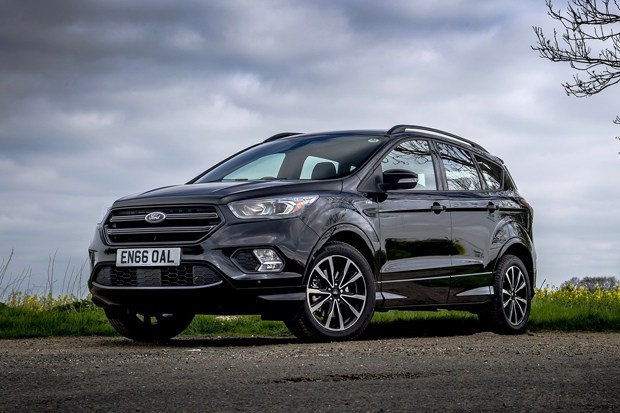
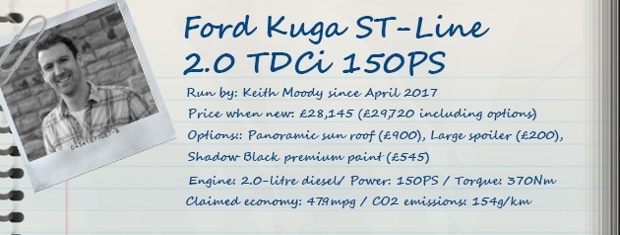
- It's a Kuga, but not as we know it
- Ford Kuga takes on the family holiday
- Niggles nibble at our long-term Ford Kuga
- Park assist proves a useful option on our Kuga
- Kuga is full of Ford’s fun factor
- Is the Ford Kuga better than the Peugeot 3008?
- How does Apple CarPlay work on the Ford Kuga?
- What is the real mpg of the Ford Kuga?
- Why our Kuga is a real rock and roller
- Which Ford Kuga should you choose?
- Our Ford Kuga is a touch sensitive
- Farewell, Ford Kuga
It's a Kuga, but not as we know it
Old car nut Keith gets excited when he hears he's getting a Kuga. No, not that one...
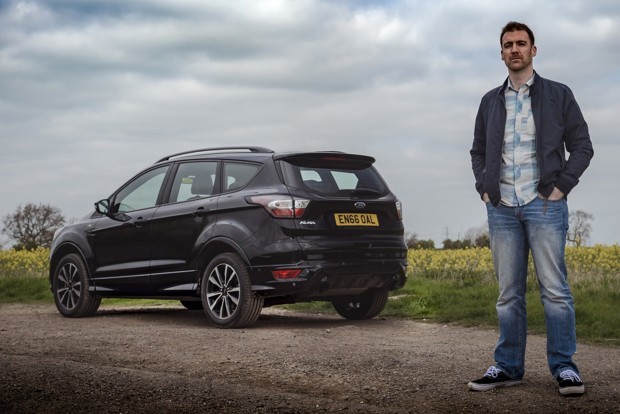
Date: 20 April 2017 | Current mileage: 2114 | Claimed economy: 60.1mpg | Actual economy: 39.7mpg
This wasn’t what I was expecting. When HJ Editor David Ross told me my next long-termer would be a Ford Cougar, I was over the moon. As Editor of Honest John Classics, a Cougar was right up my street. Ford’s turn of the century Mondeo-based two-door coupe was a classic waiting in the wings. A V6-powered classic nonetheless.
However, it transpired that – as is often the case at home – I was in the wrong. The car being delivered was in fact a Ford Kuga. ‘What’s a Ford Kuga?’ my eldest daughter asked me. ‘A slightly American-looking SUV… only without a V8,’ was the best consolation I could offer. I could have mentioned the fact it was built on the same platform at the Ford C-Max, but Peppa Pig was on and sometimes you just can’t compete.
As so often with little people, pictures speak louder than words. So I set about trying (and failing) to point out a Ford Kuga on the road. Having just revised the previous model, there were none to be found. Not one.
The second our car arrived, it was a very different story. Coming into my village on the drive home I was stuck in a three-strong Kuga convey. Now I see them everywhere, mainly finished in black or white. Hardly surprising as the Kuga is the subject of a fairly substantial sales push with some websites offering hugely competitive PCP deals.
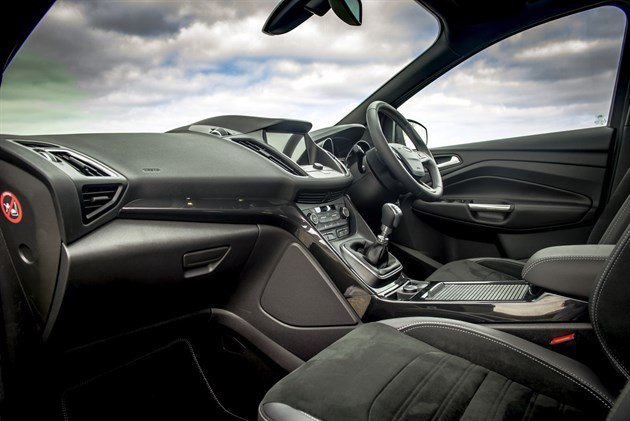
According to the marketing, you can get into a Kuga for around £22k. As with most Fords, the Kuga comes well specified as standard – but most will have a few options’ boxes ticked. Ours is a Kuga ST-Line 2.0-litre TDCi six-speed front-wheel drive model.
It has an on-the-road price of £28,145. And for that you get 18in alloys, body kit, park assist and sensors, sports suspension, rain-sensing wipers, and quick clear heated windscreen. There’s also air-con, keyless start, cruise control, tyre pressure monitoring, and electronic stability programme.
Options include the Shadow Black paintwork (£545), large rear spoiler (£200) and panoramic sunroof (£900) giving ours a total on-the-road price £29,790. We’re still a few creature comforts short – there’s no electronically-operated tailgate or keyless entry… things that we’ve found useful in previous cars (especially when you’ve got your hands full of children, prams, and paraphernalia).
Over the next few months, we’ll be putting the Valencia-assembled Kuga to work as a family car. There’ be holidays and high days, tantrums and tyre trouble, and no doubt some moaning about fuel economy. Of course, if I really wanted to moan about mpg then I could just buy a V6 Cougar. A proper one.
Ford Kuga takes on the family holiday
Just weeks into its tenure, our long-term Ford faces a tough task
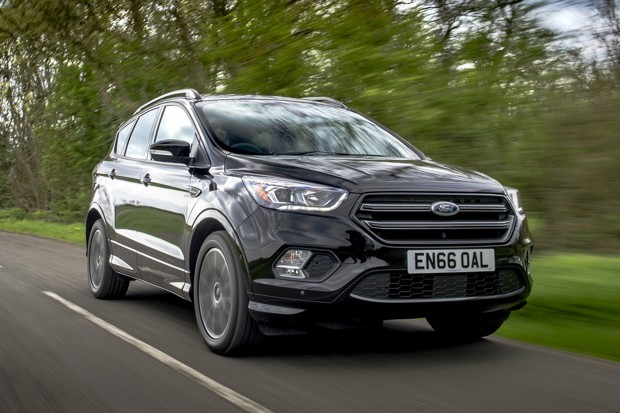
Date: 4 May 2017 | Current mileage: 2448 | Claimed economy: 60.1mpg | Actual economy: 39.7mpg
Just a few weeks after taking the keys to our new long-term Ford Kuga, it was pressed into service for a family holiday over Easter. This, so often, is the death knell for many a car. Our long-term Skoda Superb Estate arrived pristine and with just 70 miles on the clock. A week later, it was ruined with an interior fit for nothing more than burning.
Going from the Superb to the Kuga has been a bit of a shock, especially when it comes to luggage capacity. The big Skoda’s carrying capacity was of interstellar proportions – it was a black hole into which anything loaded was gobbled up. A whopping 1950 litres, compared to the Kuga’s 1603-litres doesn’t sound like a big difference, does it? But it is.
The Skoda offered a great deal of horizontal space, whereas the Kuga’s boot space is vertical. And here we come to one of the car’s weak spots – there’s no netting to divide the rear seats from the boot. So, in reality, you can't stack the Kuga very high with luggage – otherwise you'll find a suitcase flying over the seats when you brake.
That said, the second generation Kuga is better than the model it replaced in terms of carrying capacity. And it did take two massive suitcases, a smaller suitcase full of toys, two toy prams, a stroller, coats, dolls… pretty much everything a family of four needs for a few days away.
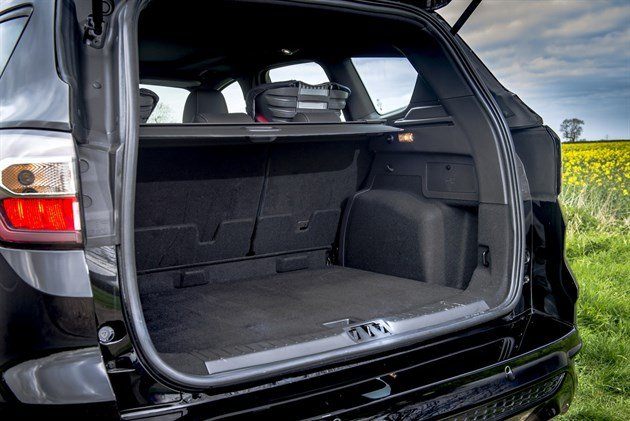
Kuga's boot space is better than it looks, but there's no vertical divider so stacking high isn't an option.
Although the rear seats are moveable, I haven’t missed being constantly kicked in the back. The Superb spoilt us with having limousine-sized rear legroom. And at least the rear seats in the Kuga are flat – so often they’re sculpted, which makes it really difficult for them to accommodate a child seat that fits into a three point seatbelt.
The seats do offer a 60/40 split, which is handy given the shallowness of the Kuga’s boot. They also fold fairly flat (although the rear bench seats don’t fold down) and it’s easy to do with the touch of a button. Well, more of a lever. So while it’s not perfect, it is perfectly serviceable.
Any more niggles? Well, there is one. You see, because the rear seats recline then they can end up quite a distance from the parcel shelf. Even reclining them back a bit leaves a gap. And unlike rival manufacturers, the retractable load bay doesn’t have any extra material to hook over the seats. It’s hardly the end of the world, but it is below par.
And because it’s a Ford, it’s fitted with cheap carpet in the boot. In fact, I’m not really sure it could be called carpet at all. It’s a bit like they’ve sprayed threads straight on to the glue. Anyway, the result is the boot 'carpet' acts like Velcro and is impossible to hoover. So it’s still covered in bits of pork pie, dolls hair, and unspecified matter.
Niggles nibble at our long-term Ford Kuga
After a month of living with our Kuga, we've uncovered a few gremlins. Keith explains all...
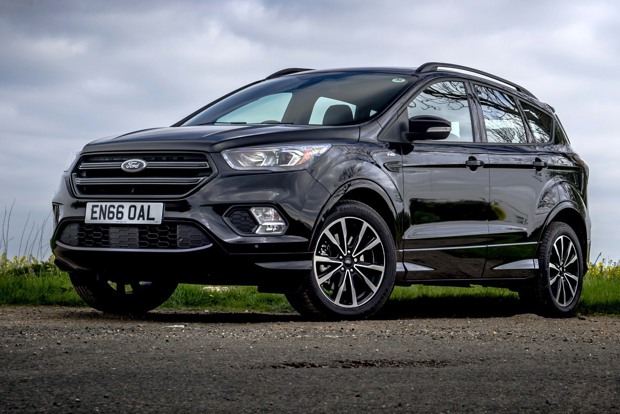
Date: 18 May 2017 | Current mileage: 3111 | Claimed economy: 60.1mpg | Actual economy: 40.2mpg
In the four weeks that we’ve had the Kuga, we’ve noticed the car suffers from quite a few niggles. Ours is yet to tick over the 5000-mile mark so we may be able to put them down to teething troubles, but it would be interesting to know if any other owners are experiencing similar problems.
Issue number one is a boot that won’t stay closed. At first, I put this down to operator error – I thought I must have accidentally been hitting the boot release switch on the key fob. But I’ve been extra careful since then and it is now fairly common that after opening the car, I’ll get behind the wheel to see an error message telling me that the ‘liftgate’ is open.
I don’t really know what a liftgate is, but if it’s the boot then it’s not open. Sometimes opening and shutting the boot clears the message, sometimes it doesn’t. Last week I had to drive home from London with the error message displayed. I stopped a few times to check the boot and it was fine, but when I got home it was indeed on the latch.
Another gremlin is the electric handbrake. It doesn’t automatically come on when you bring the car to a standstill, so you have to manually engage it. Not a problem, but the switch doesn’t always engage the handbrake. We’ve learnt the hard way to triple check the handbrake’s on after our car nearly rolled away. It’s definitely one of those situations where a traditional handbrake would have been so much better.
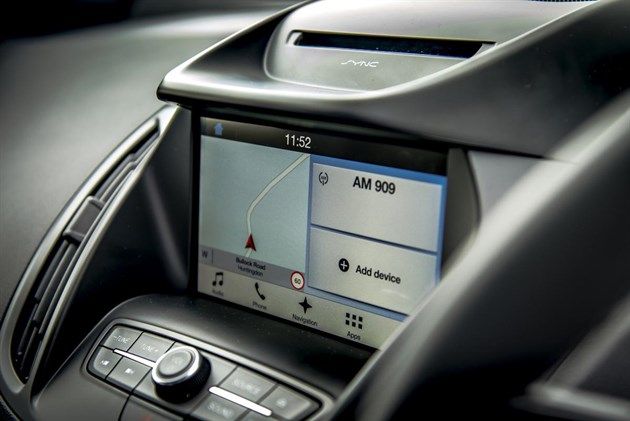
Our Ford Kuga's radio has a mind of its own
We’ve also had to put ‘injector cleaner’ on the shopping list. The Kuga either doesn’t like the local brew, or is gunked up already as power delivery can be quite agricultural at times. Far from a smooth delivery when you put your right foot to the floor, the result is several ‘flat spots’. Again, it’s an intermittent thing, but it is annoying.
Other issues? Well, there are a couple of silly ones. No matter what station and frequency the radio is left on, it seems to default to 909AM whenever you get in. And if you use Apple Carplay, then your music will start playing when you plug your device in, before stopping abruptly.
Then there’s the issue with the rear seats. The parcel shelf doesn’t have a dog-guard style vertical net, so stacking luggage too high can be rather dangerous. And nor does the parcel shelf have an extra bit of material that reaches to the rear seats, so you’re just left with an unsightly gap.
Finally, the steering wheel-mounted controls are poorly designed. Whereas some manufacturers choose to raise (or sink) the buttons, Ford has gone for all flat buttons. So, for example, if you need to cancel or re-engage the crusie control, you can’t feel for the button using your sense of touch – you have to take your eyes off the road and look down at the steering wheel to find the right button to press. If the cruise control was adaptive and picked up slow-moving traffic ahead and adjusted your speed, it wouldn’t matter so much – but this is the old school style 70mph or nothing system.
In total, it doesn't ruin the Kuga experience, but it does leave you wondering why none of this was sorted at the development stage...
Park assist proves a useful option on our Kuga
The Kuga might be a big car, but parking it is no drama thanks to some handy tech

Date: 1 June 2017 | Current mileage: 3799 | Claimed economy: 60mpg | Actual economy: 40mpg
Our long-term Ford Kuga has a couple of neat tricks up its, er, wheelarches. So we thought we’d take a closer look at one of them – it’s ability to park itself. Actually, the Kuga doesn’t really park itself – yes, it’s a ‘hands off’ system, but you still need a driver.
Engaging the system is done by the push of a button letting the car know you’d like park up. You then choose between parallel or perpendicular parking, before using your indicator to tell the system on which side of the road you’d like it to look for a space.
The car alerts you once a space is found, and the parking procedure begins. The driver is asked to follow the on-screen directions (drive forward, stop, engage reverse). You can take your hands off the wheel to scare your passengers, but you’ll need to be in control of the forward, backward, and stop bits.
I’ll admit that it’s a bit daunting taking your hands off the wheel, but at least you’re in control of linear movement so you can stop the car if there’s a problem, like a football bouncing out from the parking space behind you… followed by a child.
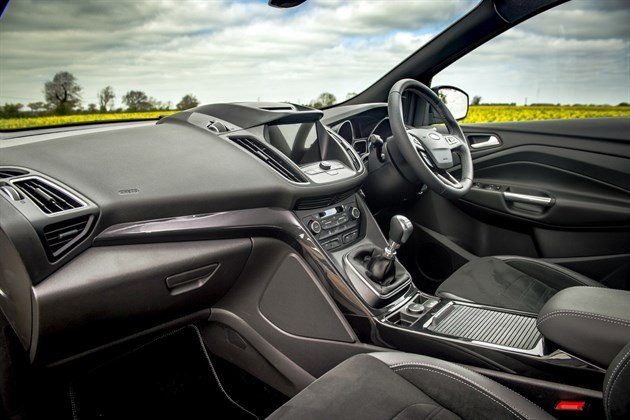
We’ve driven a few cars with these systems. With our long-term Citroen C4 Grand Picasso, you never knew if the system would work or not – it was a gamble. When it did work, it would often leave you in a bit of a jam. Parallel parking wasn’t too bad, but perpendicular parking created a few ‘exit via the sunroof’ moments.
So how does the Ford compare? Well so far, it’s 100% reliable – no pressing the button only to be ignored. It’s also sensible – willing to take sharper angles that most drivers would be prepared, but nothing drastic. In fact, our only complaint is that when the manoeuvre is finished, the car is too far from the curb. This wouldn’t matter in a Fiesta but the Kuga is a bit of a wide boy.
Having looked through the menus, it doesn’t seem that there’s any way to adjust this. Which makes us quite grateful that the door mirrors tuck in when you lock the car - otherwise they’d probably get taken off. Another niggle, is the parking sensors - which seem to go from green to red in the blink of an eye. One second you think you've got loads of space, the next the car's warning you to brace for impact.
Because the Kuga is such a big car, we’ve found the park assist useful. It gets us into those spaces that you’re 70% sure the car would fit in, but 100% sure you would never attempt it (especially if there’s a stack of cars behind). Park assist is standard on our ST-Line but if you want to add it as an option its £450. That's the price of being a parking hero.
Kuga is full of Ford’s fun factor
Keith finds out that, despite its size, the Kuga is pretty decent to drive
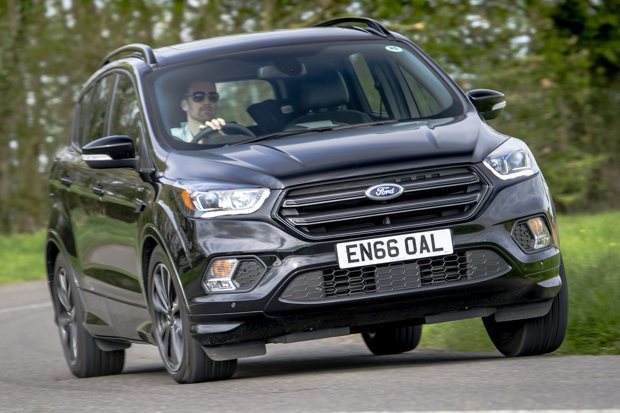
Date: 15 June 2017 | Current mileage: 4459 | Claimed economy: 60.1mpg | Actual economy: 41.1mpg
Since the Ford Focus was launched way back in 1998, Ford has gone out of its way to make its cars handle smartly. It’s a process that arguably started with the Escort and was led by Welsh-born engineer Richard Parry-Jones.
One famous story about Parry-Jones, who was Ford’s group vice-president and chief technical officer, is that he urged engineers to test the car in the real world. So rather than putting in lap after lap at full tilt, he encouraged them to drive the car slowly over 50 metres to find out what it really drove like.
And even though he retired from Ford in 2007, his legacy is still evident in many of Ford’s products today. In fact, it’s thanks to his hard work that the Kuga can make a decent claim at being the best handling car in its class.
Don’t get me wrong – we’re not tooling about in the Kuga, left-foot braking, and bouncing it off the limiter and ditch hooking at every opportunity. In fact, most days, the Kuga spends its life trundling around town to drop the kids off before hopping up the A1 to the office.
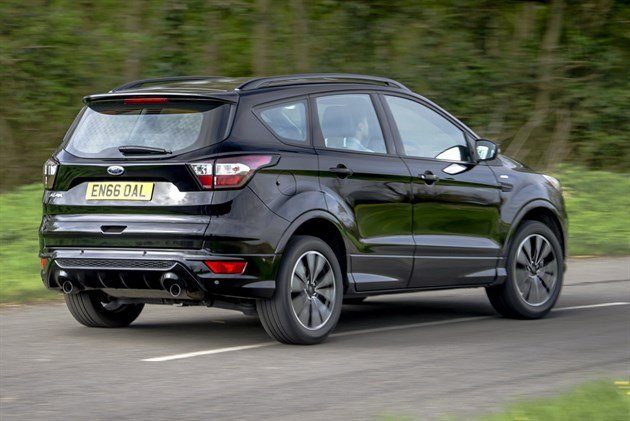
Ford Kuga handles neatly for a car of its size
But living in Cambridgeshire means we get our fair share of traffic problems and congestion. The roads on my regular commute often break and I’m forced to zig-zag my way across the Fens to make it home in time to get the kids.
Normally, I’d roll my eyes at the thought of doing B- and C-roads in a high-sided SUV (at least without at packet of Kwells or a V8), but give the Kuga its dues – it can make decent progress when it needs to. Our long-term test car has the ST-line pack, which includes a sporty suspension but doesn’t damage the ride around town.
Okay, you can’t beat the laws of physics, and if you carry too much speed into a corner, it will lose grip at the front. But the Kuga certainly wins compared some of the other cars in its class whose handling characteristics can at best be described as numb. And while the 150PS diesel engine might not be the most powerful, its 370Nm of torque is enough to pull you around, especially as its available right where you need it – in the middle of the rev counter.
It’s this aspect of the Kuga that we’ve enjoyed. We could definitely live without the niggles, though - like the constant error message 'liftgate' open and parking brake that more often than not fails to engage.
Is the Ford Kuga better than the Peugeot 3008?
We get behind the wheel of the Kuga's competition to see how it compares
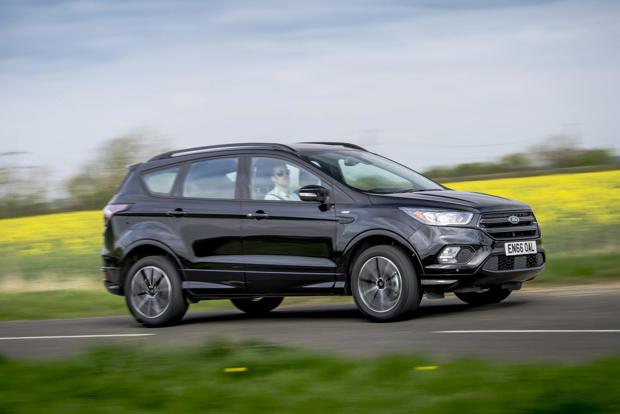
Date: 29 June 2017 | Current mileage: 5985 | Claimed economy: 60.1mpg | Actual economy: 38.1mpg
There’s no doubt about it – the Ford Kuga sits in one of the most competitive sectors around. So, to see how it compares to the competition, we’ve spent the past week getting to know one of its main rivals – the Peugeot 3008.
First impressions are telling. The Peugeot instantly feels more solid and better bolted together than the Ford. The seats are supportive and comfortable – unlike the Kuga’s. Just driving the Ford around town feels like you’re getting a solid core workout as your muscles work to offset the bodyroll.
Around town, the Peugeot’s steering is much nicer. It’s lighter and the funky steering wheel is a neat trick. Although when you’re pressing on, the Ford feels much better with more communication through the wheel. In fact, the Kuga takes the spoils on driving enjoyment (especially with our tuned ST suspension) – the Peugeot’s nose feels very ponderous under pressure.
The gearbox and clutch combination in the French car is also a bit of a let-down. While you can merrily snick up and down the Kuga’s gearbox, the biting point on the Pug’s clutch is sharp (and feels like it’s never in the same place twice), making it a bit of chore in town traffic.
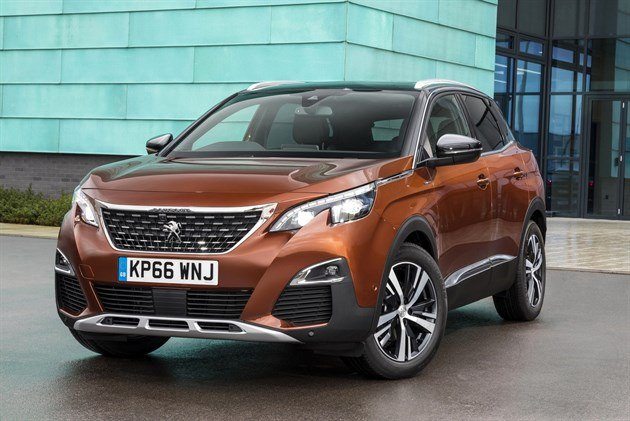
Peugeot might not be pretty, but it is packed with personality.
One big win for the Peugeot is its cabin. High quality materials are everywhere and often required items such as temperature controls, nav, and music are all on brushed aluminium switches underneath the main nav screen. The French car maker seems to have learnt a valuable lesson from sister company Citroen where everything had to be accessed via a touchscreen. Not ideal – and even less so when the screen would often freeze, leaving you with a face full of cold air when you wanted to demist the windscreen.
You also get a lot more tech for your money with the Peugeot. We didn’t realise how much we've missed things like keyless entry, reversing camera, and an electrically-operated tailgate until now. The Ford seems to handle Apple’s CarPlay better, though – with the Peugeot taking an absolute age to connect. Neither nav system is perfect - the Ford has never once remembered our home address, for example.
In terms of space, the Peugeot feels more cramped especially with the kids in the back. But part of this might be a trick of the design. The high sides of the 3008 give the impression of safety and security. In fact, the 3008 has more boot space than the Kuga – 520 litres compared to 406. With the seats down, the Ford wins with 1603 litres (compared to 1580).
Engine-wise, we weren’t able to compare like with like. Our £30k Kuga is fitted with a 2.0 TDCi diesel, while the £26k Peugeot had a 1.2-litre three-cylinder petrol. Don’t knock that petrol until you’ve tried it, though – it is a cracking little engine and only really struggled when you got up to motorway speeds. So, which would we have given the choice? Well, as much as we love the Kuga’s driving dymanics, the Peugeot is more comfortable and just has more personality.
How does Apple CarPlay work on the Ford Kuga?
We road test the Ford's infotainment system, including Apple CarPlay connectivity
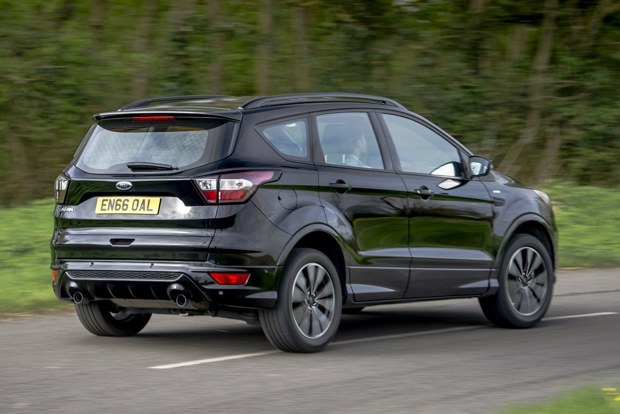
Date: 13 July 2017 | Current mileage: 6888 | Claimed economy: 60.1mpg | Actual economy: 38.1mpg
Last time we had a Ford Kuga on long-term test, we had a few issues with the infotainment system. The main problem was that iPod connectivity stopped working. But there were other issues such as the vehicle battery draining as the unit constantly tried to wirelessly connect to a smartphone.
Thankfully, those issues haven’t re-appeared this time round, thanks to a new infotainment system in the updated model – although it still has a few foibles. That’s nothing unusual. Despite infotainment and smartphone connectivity being a major consideration for a generation of younger buyers, manufacturers still haven’t quite nailed this.
Smartphone software providers have taken the lead though - Google has Android Auto, while Apple has CarPlay. While we haven’t been able to road test the former, we have been able to put the Apple system through its paces.
In this case, it’s as simple as plugging your phone into a lead that connects to a USB port on the vehicle, which is hidden in the centre armrest. This isn’t an ideal location as it means you’ve got a wire trailing out. And while there is a narrow tray for your phone in the centre near the gearbox, it’s not suitable for larger phones or ‘phablets’ like the iPhone 7 Plus.
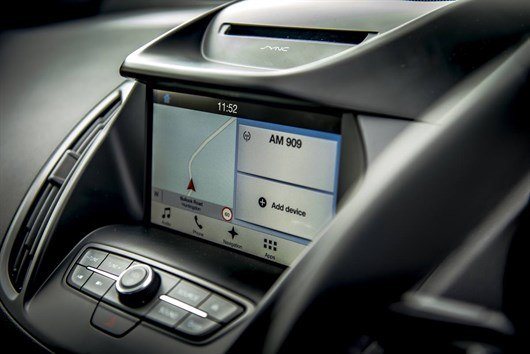
Our Kuga's 8in colour touch screen works with Ford's infotainment system and Apple's CarPlay.
Again, not many manufacturers have cracked this – but things are a lot tidier when there’s a decent phone cubby that sits forward of the gearbox with a nearby port, allowing the lead to be tidied away. Why don’t I just stash my phone away in the cubby? I’d love to, but…
The system has a habit of crashing. This occurs when the audio from the music becomes ‘fragmented’ and starts to skip, stutter, or sound like it’s being played from a speaker under the sea. In this case, you need to unplug and plug it back in again for normal service to be resumed.
Generally, it’s pretty good. And we much prefer the instant map and traffic updates when using Apple Maps. Plus, unlike the Ford navigation, the phone can remember a home address. We’ve tried four or five times to fix this on the Ford system, but it never seems to recall where we live.
Forgetfulness is a bit of theme with the Ford unit actually. For a start, it never remembers which station we were last listening to… although at least it’s stopped piping through TalkSport as a default option.
To its credit, the Ford system is capable of using Siri – apple’s voice-controlled assistant. You simply press a button and issue a command. This could be playing an album, getting directions home, or sending a text message. Obviously it’s not perfect, but it is definitely a step in the right direction towards combating driver distractions.
What is the real mpg of the Ford Kuga?
We look at the real-life fuel economy of Ford's popular crossover
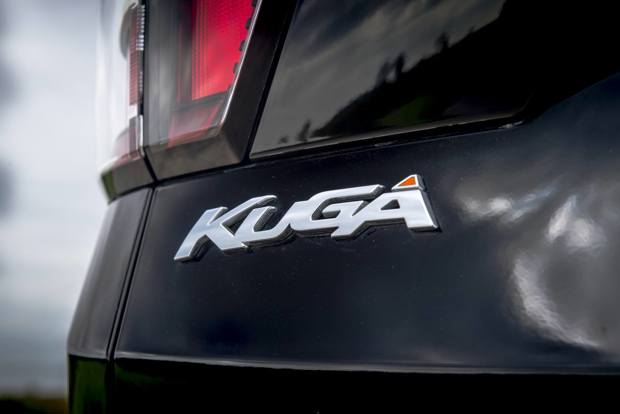
Date: 27 July 2017 | Current mileage: 8021 | Claimed economy: 60.1mpg | Actual economy: 38.1mpg
After five months with our Ford Kuga, we ‘ve seen some pretty consistent fuel economy figures. Most of the readings have been around the 40mpg mark – which is some way short of the official figure.
According to the data, our 2.0 TDCi 150PS front-wheel drive Kuga should deliver a combined mpg figure of 60.1mpg. Sadly, no-one ever expects a car to hit its official figures these days as manufacturers seem to push the envelope of what’s achievable.
We spent a week driving as economically as we could (think gentle acceleration, cruising at slightly below motorway speeds, making sure we weren’t carrying around any extra baggage in the boot... that sort of thing) and the best we could do was 44mpg.
Our Ford Kuga lives a fairly typical life. Most days start with a ten minute drive in stop-start traffic to drop the kids off at school, before a steady trip up the motorway to work. A few times a month, the car is pressed upon to do longer work-related journeys.
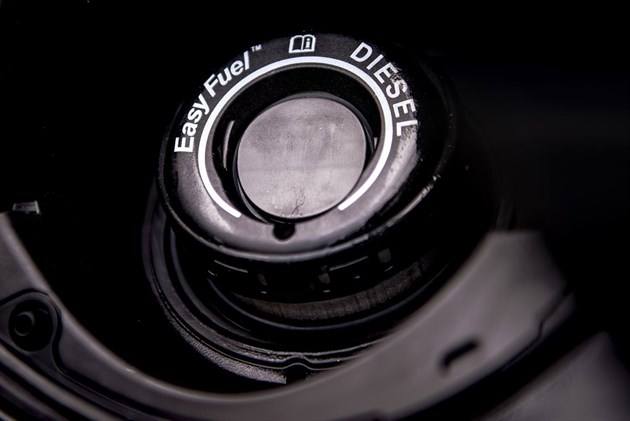
Easy Fuel system means misfuelling (and lost filler caps) are a thing of the past.
And at least once a month, the road network where we live completely falls over, which results in long periods waiting patiently in stationary gridlock, dawdling through 40mph motorway roadworks, or taking an impromptu scenic route to work.
Nothing unusual about any of that – and hopefully it gives you a good idea of what you can expect if you purchase one. In fact, according to our Real MPG data we’re about on the money. Owner data creating an average of 42.9mpg – or 71% of the official figure.
Lately, our economy has dipped as we’ve been long-term testing a childseat. The Multimac is a new unit that allows you to get three or four children across the back seat. It’s arguably cheaper than changing your car to a van with seats, but its ruggedness means its weights 40kg. That’s like having two full suitcases in the boot all the time.
The Multimac is due to be removed before the Kuga goes back, so we’re aiming for one more economy run before we have to give return this SUV to Ford. Who knows, with 8000 miles on the clock now (and the diesel engine running well), we might be able to coax a few more miles to every gallon.
Why our Kuga is a real rock and roller
Electronic parking brake problems and poor seats mar the Kuga experience.

Date: 10 August 2017 | Current mileage: 9235 | Claimed economy: 60.1mpg | Actual economy: 42.1mpg
So far, our Kuga’s been a decent performer – but it does have a few niggles, not least of which is the electronic parking brake. I’ll confess now that I’m not a fan of these systems. I’ve no idea what was wrong with the handbrake or why manufacturers felt the need to dispense with them.
The official story is that electronic parking brakes were introduced to save weight and space. Quite how that’s the case, I’ve no idea – I’d say the best case scenario is that you gain an extra cup holder. At worst you get a car that rolls away.
There’s no two ways about it, electronic parking brakes are horrible – and the one on our Kuga is no exception. The little plastic flap that drops anchor after you park up is not an item you can count on. You need to double and triple check that it’s actually engaged as we’ve been caught out multiple times.
Personally, I think that if manufacturers are going to fit electronic parking brakes as standard, then they should also come with an auto-hold feature for hill starts and a feature that automatically engages them after you turn off the ignition.

Sports suspension means our Kuga handles neatly, but lack of supportive seats lets the car down.
Other niggles? The seats. Our car is fitted with the ST suspension kit, which means it handles neatly enough and rides a bit harder that the standard model. Trouble is, this sportiness isn’t matched by extra driver support up front.
Sure, everyone is different – but at 6ft, I’m not overly tall. And I’m certainly within the healthy range of my BMI. But living in the flat lands of Cambridgeshire means I regularly have to use roads that are full of twists and turns and poorly surfaced.
And with side bolsters that don’t fit me well, lumbar support that’s in the wrong place, and an upright seat back that promotes a curved spine, I have to say that I’ll be glad when the Kuga returns to Ford. And so will my back.
Which Ford Kuga should you choose?
With six trim levels to choose from, how do you know which Ford Kuga is right for you?
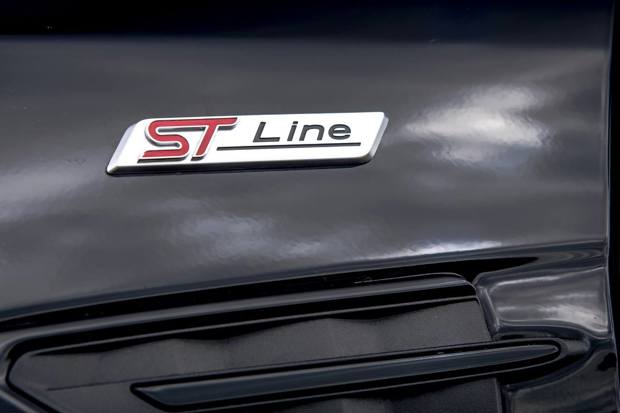
Date: 24 August 2017 | Current mileage: 10,154 | Claimed economy: 60.1mpg | Actual economy: 42.9mpg
When it comes to choosing a new Ford Kuga, there are plenty of things to consider – from how much you want to spend to whether you want a petrol or diesel. The largest car manufacturers can often have a confusing line-up of trim levels – a consequence of trying to be all things to all men. However, Ford has worked hard in recent years to simplify its range.
Buyers have six trims levels to choose from. The entry-level Zetec model comes with DAB, air-con, USB and Bluetooth connectivity, electric windows and keyless start. Buyers also get 17in alloy wheels, cruise control and the much-loved (although expensive to replace) Quickclear windscreen.
Step up to Titanium and you’ll drive away with part-leather upholstery, automatic lights and wipers, auto-dimming rear-view mirror, and dual-zone climate zone. Also on the car will be rear parking sensors, and Ford's Sync3 infotainment system complete with an 8in touchscreen display, sat nav and DAB radio.
Upgrade to Titanium X and you'll get 18in alloy wheels, a full leather upholstery, a panoramic roof, powered tailgate, xenon headlights and heated front seats.
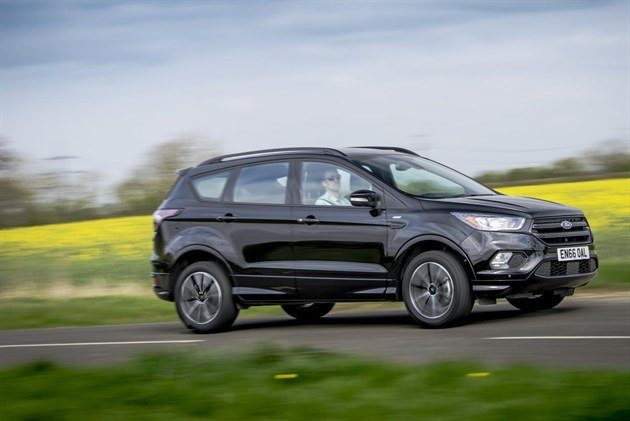
Our long-term Kuga is in ST-Line spec with dark alloy wheels and a bodykit.
But what if you fancy something a bit sportier? That’s where the ST-line and ST-Line X models come in. These have 18in dark alloy wheels, bodykit, active parking assist, front and rear parking sensors, sports seats, firmer suspension and black roof rails.
The ‘X’ on the back marks options such as a panoramic roof, keyless entry, 19in alloy wheels. There’s also an electrically adjustable driver's seat, manually adjustable front passenger seat with both heated too.
Sitting at the top of the pile is the Vignale. You get all of the above, but with a unique bodykit, LED rear lights, premium floor mats, and unique leather upholstery. Then there’s a reversing camera and a nine-speaker Sony audio system.
As you can see, even the most basic car is pretty well equipped so you won’t be disappointed – from there on in it’s just a question of how much money you want to spend.
Our Ford Kuga is a touch sensitive
Flimsy controls and a poor infotainment system let our long-termer down
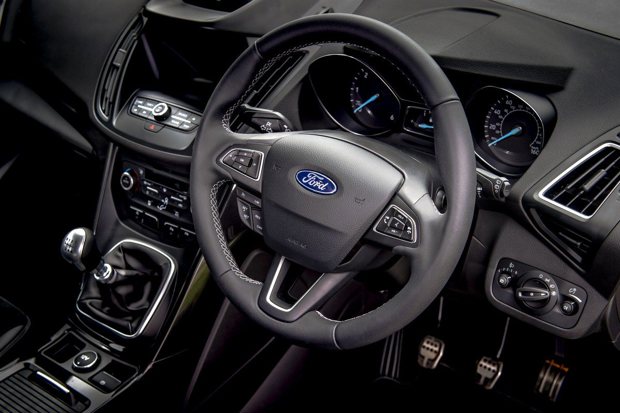
Date: 5 September 2017 | Current mileage: 11,111 | Claimed economy: 60.1mpg | Actual economy: 44.5mpg
Over the past six months, we’ve been able to find out what’s really good (and not so good) about the latest Ford Kuga.
There’s certainly plenty that we like about it. Like the amount of space for rear seat passengers. Or the decent boot space available. Then there’s the handling, which we’re pretty sure must be one of (if not the) best in class. Even the fuel consumption’s improved, with 45mpg now possible (although it’s still nowhere near the official figure of 60mpg).
But you’re not here to read about what’s good. You want to know what it’s like to live with on a day-to-day basis over the long term – all those little niggles and frustrations that spoil the ownership experience. And we’ve uncovered a few of those – not least of all the touch sensitivity of the Kuga’s controls.
Specifically, the temperature. The slightest touch will see the temperature change from 18 to 23 degrees. That’s as long as you don’t go over a bump or a pothole…
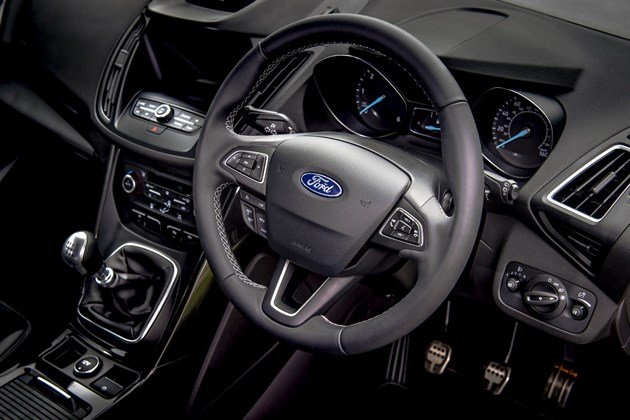
Lightweight temperature controls frustrate the driver.
The problem? Two-fold. The space between the temperature increments is tiny, so it’s far too easy to rattle from too cold to too hot in the blink of an eye. And there’s not enough weight (or perhaps damping) to the control knob, which makes it easy to spin round rather than pinpoint the setting you want.
Sounds trivial, doesn’t it? But it’s become one of the most annoying things about the car. That and the navigation from the car’s in-built infotainment system.
Here, the issue is that – no matter how many times we input our home destination – it never remembers. In the end, we just gave up and stuck to using Apple’s CarPlay system in tandem with our smartphone. At least that remembered where we lived.
CarPlay also remembered what song we were listening to – unlike the Ford system. Which seems obsessed with defaulting to one (particularly terrible) talk radio station. Ultimately, none of these are deal-breakers – but we expected better.
Farewell, Ford Kuga
After six months, it's time to say goodbye to the big Ford. But will it be missed?
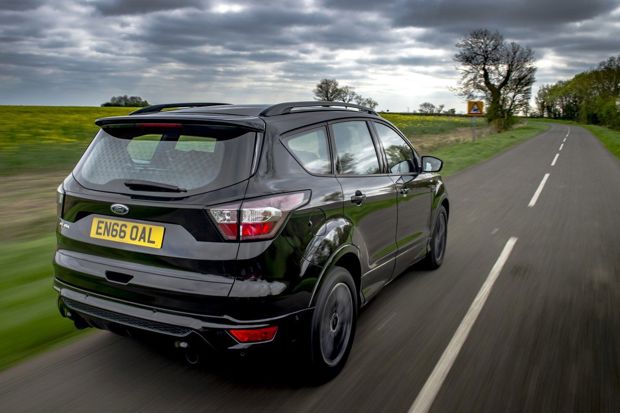
Date: 21 September 2017 | Current mileage: 11,973 | Claimed economy: 60.1mpg | Actual economy: 42.5mpg
After six months, it’s time to say goodbye to our long-term Ford Kuga. And we’ll be the first to admit it took a while for us to get used to the big Ford, we’re actually going to miss it.
There are plenty of reasons for this. First of all, it’s quite spacious – there’s plenty of room for the kids and the luggage in the boot. Although the height of the boot (or rather the lack of a dog guard) means that you can never fully utilise that space without running the risk of flying objects.
We’ll also miss the way it drives. Yes, despite its size the Kuga is actually a blast to drive on the back roads – easily one of the best-handling cars in its class, thanks in part to the lower, stiffer, and sportier ST suspension kit. But the steering is quick and – as we’ve come to expect from a Ford – the chassis is excellent.
Mated to the 2.0-litre TDCI, you can make pretty good progress… once you’re up and running. The oil-burner isn’t the quickest off the mark from a standing start taking 10.1 seconds to get to 62mph. But once you’re up there, you’re underway you’ve got 370Nm of torque to play with, most of it accessible from lower revs. Although we found that with some fuels it had a noticeable flat spot.
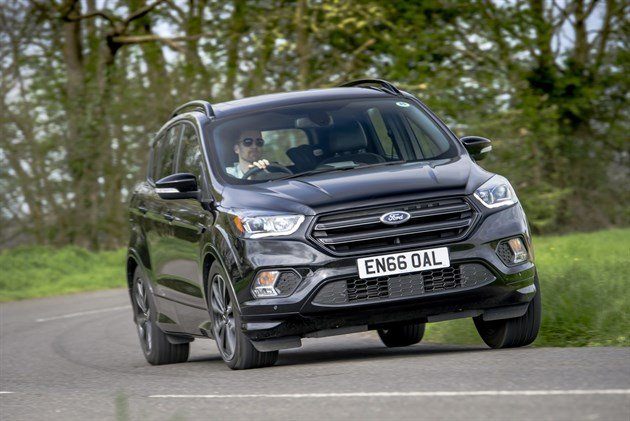
Ford Kuga handled brilliantly thanks to the sportier (optional) ST suspension.
It’s a good engine and copes admirably with the rigours of day-to-day life. Official fuel consumption figures are 60.1mpg – but the best we managed was 49 on long run but 43 was typical. Not bad for a car of its size and bang on the money of what our RealMPG users get from the car.
Niggles? We had a few. Initially, the boot wouldn’t register as being closed – but after a few thousand miles this problem disappeared. We never won the battle with the electric handbrake and just had to resort to repeatedly making sure it’s engage. Even now, it’s temperamental.
But the car’s real weak spot is the way it interacts with the driver. For example, the steering wheel-mounted controls are poorly designed. When it comes to cruise control, you can’t ‘feel’ which button does what – you just have to take your eyes off the road.
The infotainment system never remembered which radio station we were last using and defaulted to TalkSport. And the navigation system never remembered our home address – in the end we just stuck with Apple’s CarPlay (which works even better since the iOS 11 update).
No matter how you look at it, the Kuga is an expensive car. Our Kuga cost £29,790 on the road and came with ST kit, rain-sensing wipers, and Quickclear windscreen as well as the panoramic sunroof. But despite the high price, it didn’t come with things that keyless entry and an electric tailgate – two options that we’ve come to appreciate when you’ve got your hands full with the kids.
It’s not perfect – but if we were in the market for a crossover, we’d buy the Kuga… and haggle with the dealer on spec and price.
